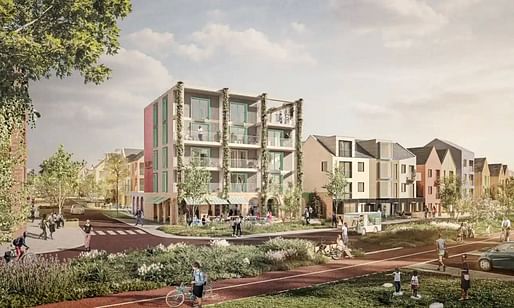

What will homes of the future look like? According to a recent UK housing competition, Home of 2030, selected winners have an idea. However, are these ideas all that new? The Guardian's Oliver Wainwright unpacks these winning design proposals and explains, "according to the winning architects, most of the best ideas have been around for generations."
RIBA and the BRE organized the HOME of 2030 competition on behalf of government departments within the UK. The winning projects were asked to design "environmentally friendly homes that support people in leading independent, fulfilling lives as our society ages."
Wainwright chats with Openstudio's Jennifer Beningfield to unpack their project Connector Housing. Beningfield explains, "You can't get much more flexible and adaptable than the Georgian townhouse. We've taken this very simple model and updated it for the 21st century. Our idea was to create infinite choice and variation from something very simple." He also connects with igloo Regeneration founder Chris Brown and the intentions his firm has towards implementing their winning design into practice as well as the obstacles they'll face due to commercial constraints.
Towards the end of the article, Wainwright shares, "as is so often the case with blue-sky ideas competitions, the ambitions of the Home of 2030 winning teams are admirable – and, in this case, eminently buildable – but there is little evidence to suggest that either the government or the volume housebuilding sector has any intention of putting them into practice. For that, we must look to Sunderland in 2023, and hope that a progressive coalition of other councils, communities and smaller-scale builders have the imagination to follow their lead."
7 Comments
Developers, lawyers, planners, and manufacturers are the ones who make or break innovation. Rarely do designers have the ability to marshall financing packages, make the most out of tax breaks and zoning codes, or develop new materials and manufacturing processes. Some architect-developers like OJT accomplish these on a smaller scale, while those who branch into manufacturing have had a harder time gaining traction in this country (Katerra, Skender, Cover etc). Money, law, and gravity dictate the pace and place of development - architects can position themselves in an advisory role to the power brokers that be if they do not possess the ability to be in power themselves. Brand name designers (even those from other arenas) like Heatherwick are now hired for adding a stylistic touch to branded projects while the rank and file AORs produce drawings and coordinate. This really isn't innovation.
^ I agree with this basic notion.
However, the money folks can't draw (to put it in simplistic terms). They hire people who can draw-- and can speculate and fantasize and hypothesize in visual form that illustrates ideas to others. It's painfully true that architects and designers can't bankroll a Big Idea. But the promoters and developers need someone to do the visioning. This is, I think, a critical aspect of our profession that we haven't yet relinquished. I hope we don't.
I agree completely. The visioning part is exactly what architectural designers should do to stand out. It is also what designers from other professions are trying to do, from fashion designers to even musicians who are lending their brands to the built environment. I know I harp on Heatherwick a lot but he really has the ears of quite a few power brokers, having built a reputation (deserved or not) as a man of ideas and vision. The value-add that architects provide must be more than cost and professional delivery (The latter is absolutely essential and a given) - too often I see practices either driving each other down in a suicidal price war or handing over the "visioning" part of the job to a brand name designer.
What people miss about old houses is their organic design, built with the site, climate, light and not in spite of it. Many of these house prototype focus too much on materials and production, and not the root issues of energy, climate, and costs that dictate the design variables.
Boxes work REALLY well on shelves, not so well on rocky hillsides.
what DOES work well on a rocky hillside?
Depends on the hillside. That's why we exist.
Block this user
Are you sure you want to block this user and hide all related comments throughout the site?
Archinect
This is your first comment on Archinect. Your comment will be visible once approved.